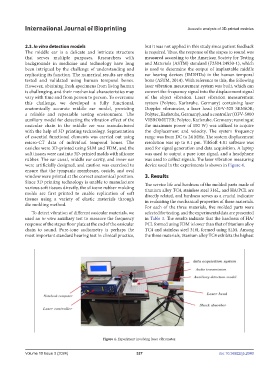Page 335 - IJB-10-3
P. 335
International Journal of Bioprinting Acoustic analysis of 3D-printed ossicles
2.3. In vitro detection models but it was not applied in this study since patient feedback
The middle ear is a delicate and intricate structure is required. Thus, the response of the stapes to sound was
that serves multiple purposes. Researchers with measured according to the American Society for Testing
backgrounds in medicine and technology have long and Materials (ASTM) standard (F2504.24930-1), which
been intrigued by the challenge of understanding and is used to determine the output of implantable middle
replicating its function. The numerical results are often ear hearing devices (IMEHDs) in the human temporal
tested and validated using human temporal bones. bone (ASTM, 2014). With reference to this, the following
However, obtaining fresh specimens from living human laser vibration measurement system was built, which can
is challenging, and their mechanical characteristics may convert the frequency signal into the displacement signal
vary with time and from person to person. To overcome of the object vibration. Laser vibration measurement
this challenge, we developed a fully functional, system (Polytec, Karlsruhe, Germany) containing laser
anatomically accurate middle ear model, providing Doppler vibrometer, a laser head (OFV-525 SENSOR;
a reliable and repeatable testing environment. The Polytec, Karlsruhe, Germany), and a controller (OFV-5000
auxiliary model for detecting the vibration effect of the VIBROMETER; Polytec, Karlsruhe, Germany; running at
ossicular chain in the middle ear was manufactured the maximum power of 100 W) was utilized to acquire
with the help of 3D printing technology. Segmentation the displacement and velocity. The system frequency
of essential functional elements was carried out using range was from DC to 24 MHz. The system displacement
micro-CT data of individual temporal bones. The resolution was up to 0.1 pm. VibSoft 4.81 software was
ossicles were 3D-printed using SLM and FDM, and the used for signal generation and data acquisition. A laptop
soft tissues were cast into 3D-printed molds with silicone was used to output a pure tone signal, and a headphone
rubber. The ear canal, middle ear cavity, and inner ear was used to collect signals. The laser vibration measuring
were artificially designed, and caution was exercised to device used in the experiments is shown in Figure 4.
ensure that the tympanic membrane, ossicle, and oval
window were printed at the correct anatomical position. 3. Results
Since 3D printing technology is unable to manufacture The service life and hardness of the molded parts made of
various soft tissues directly, the silicone rubber molding titanium alloy TC4, stainless steel 316L, and HA/PCL are
molds are first printed to enable replication of soft directly related, and hardness serves as a crucial indicator
tissues using a variety of elastic materials through in evaluating the mechanical properties of these materials.
die molding method.
For each of the three materials, five molded parts were
To detect vibration of different ossicular materials, we selected for testing, and the experimental data are presented
used an in vitro auxiliary test to measure the frequency in Table 3. The results indicate that the hardness of HA/
response of the stapes floor plate at the end of the ossicular PCL formed using FDM is lower than that of titanium alloy
chain to sound. Pure-tone audiometry is perhaps the TC4 and stainless steel 316L formed using SLM. Among
most important standard hearing test in clinical practice, the three materials, titanium alloy TC4 exhibits the highest
Figure 4. Experiment involving laser vibrometer.
Volume 10 Issue 3 (2024) 327 doi: 10.36922/ijb.2040

